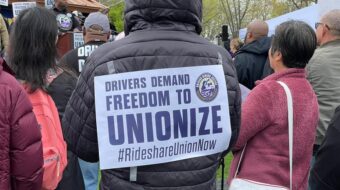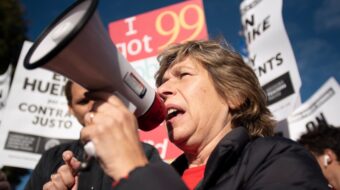
DETROIT—With 340,000 Teamsters heading for a strike their UPS bosses are forcing on them, the union picked up support from the Service Employees and from two long and strong political backers of workers, Sen. Bernie Sanders, Ind-Vt., and Rep. Alexandria Ocasio-Cortez, D-N.Y.
But what new Teamsters President Sean O’Brien and his team have yet to do is to construct a grand coalition with other unions, civic groups, and particularly with the package freight company’s customers. Doing so puts even more economic muscle behind UPS workers’ just demands, says a Teamsters veteran, Iowan Joe Henry, who went through the long 1997 UPS strike.
O’Brien has been prepping his UPS worker-members—who are one of every four Teamsters—for a forced strike for months, urging them to save up and prepare to picket and protest. There’s already been practice and/or informational picketing at UPS sites nationwide. One, in Queens on July 7, drew Ocasio-Cortez to speak and march with the workers.
If UPS “can afford AC in our trucks, they can afford to pay part-timers equal wages,” Ocasio-Cortez said about one of two concessions UPS offered before talks broke down and the bosses walked out at 4 am on July 5.
“They can pay enough to ensure people can live in New York City and across the country, they can afford enough to ensure people can feed their babies and clothe their kids, and lead a dignified life,” the lawmaker added.
Key issues are wages, working conditions, the elevation of part-time drivers, who comprise almost one of every two UPS drivers, to full-time, and an end to the firm’s onerous two-tier wage system.
That system is part of the current contract, which expires at midnight on July 31. Former union President Jim Hoffa and the union’s board imposed that pact under a now-repealed Teamsters constitution provision. The UPS workers had rejected it, and the voting turnout was too low, allowing the board to overrule the workers. The following outrage led to O’Brien’s defeat of Hoffa’s hand-picked successor.
UPS certainly has the money to pay its Teamsters more. It netted $11.5 billion in 2022 and had a 13% operating profit margin. A research report for the Teamsters forecast similar margins in future years. The workers want to share in the money they make for the company. Their repeated refrain in union videos: “We need to get paid.”
“We’re the backbone of this company,” one UPS Teamster says in another video. “We do the work every single day. They wouldn’t be able to make the money they make if it wasn’t for us coming to work every day in all types of weather conditions. We want our fair share.”
And a young African-American driver adds: “I work part-time from 4-9, and I have to work another job. Honestly what I need to see is a huge pay raise. I ain’t gonna lie. This is like a $20-an-hour job and we get paid $16-something.”
SEIU, the other big union with the Teamsters in the Change To Win coalition, chipped in with its own supportive tweet: “Union members have each other’s backs! Workers across the country are in solidarity with the 340,000 #UPSTeamsters fighting for a fair deal. It’s #HotUnionSummer because when one of us wins, we all do! #SolidaritySummer @Teamsters.”
The catch to that, according to now-retired Communications Workers President Chris Shelton, is O’Brien has yet to reach out to other unions for practical support. That’s not what happened in 1997, Henry says.
“We knew how to build the relationships” with other unions, he explained in a telephone interview. “That’s something that needs to be done. We had the AFL-CIO, central labor councils” and prominent political figures all in the Teamsters’ corner 26 years ago.
“There was a lot of pressure on the Clinton administration” in 1997 “to invoke the Taft-Hartley Act” and force the UPS Teamsters back to their jobs, Henry explained. “But we had a relationship with Clinton” and the president resisted.
Coalition-building is occurring on the state and local level, Henry conceded. But for the union to draw in partners, it must give them contract information. Henry admitted, however, that “we had four years to prepare” for the 1997 confrontation. O’Brien and his reformist team took office in January 2021.
Instead, O’Brien’s team is urging supporters to write letters, e-mails, and social media missives to lawmakers. The communications urge solons to avoid imposing that 1947 Republican-enacted anti-union law’s provisions on the Teamsters in their UPS struggle.
The union is also returning to bargaining in good faith, even if UPS isn’t, with sessions scheduled in D.C. But O’Brien previously warned the Teamsters needed a “last, best and final offer” from UPS by the day, July 5, that the bosses walked out of the talks. They didn’t get it.
That would have left just enough time for the union’s dozens of bargainers, from Teamsters-UPS locals around the country, its board, and rank-and-file members, to review and vote—one Teamster, one vote—on the firm’s proposal. Instead, they got no change from the firm’s prior wage offer. O’Brien called that an insult.
We hope you appreciated this article. At People’s World, we believe news and information should be free and accessible to all, but we need your help. Our journalism is free of corporate influence and paywalls because we are totally reader-supported. Only you, our readers and supporters, make this possible. If you enjoy reading People’s World and the stories we bring you, please support our work by donating or becoming a monthly sustainer today. Thank you!












Comments